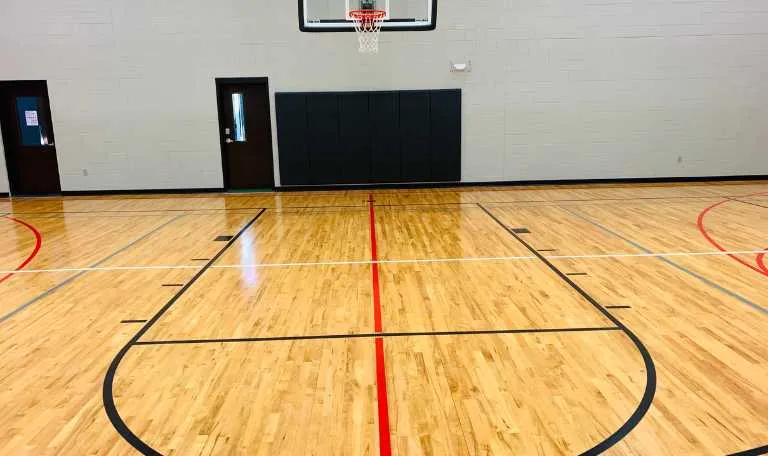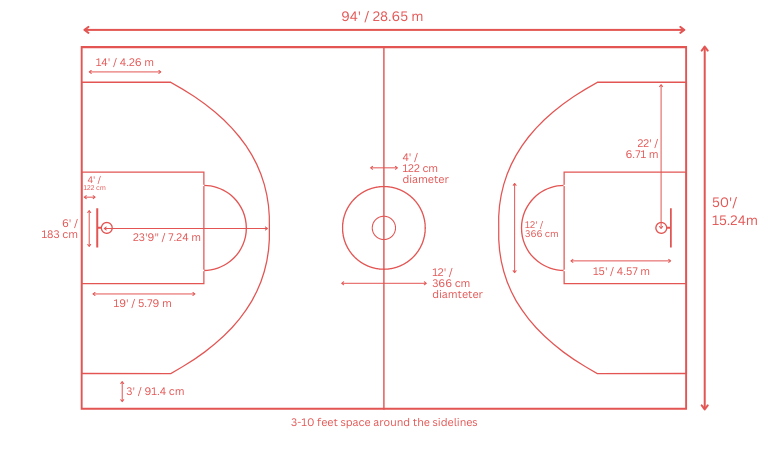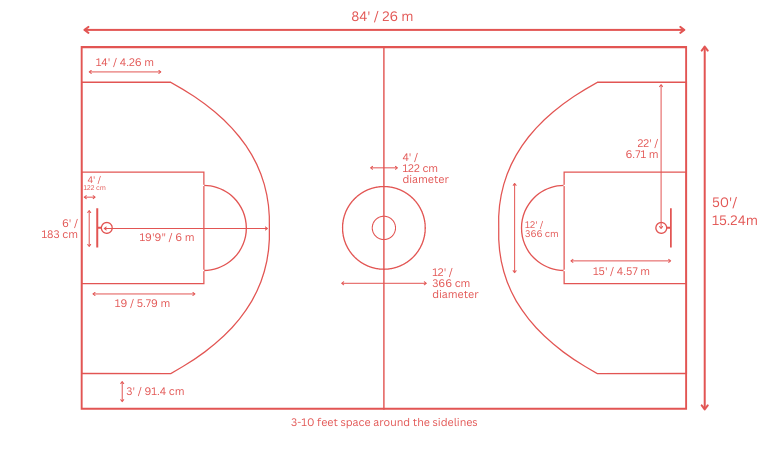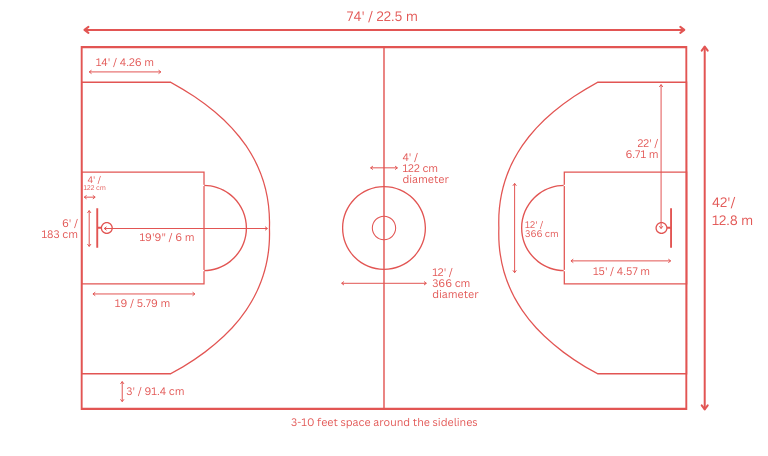Home » Indoor Sports Court » Basketball court dimensions guidelines for installation projects
Basketball court dimensions guidelines for installation projects

A new basketball court is a major investment and one that can have a major impact on a community. Whether you’re building a court for a grade school or a semi-professional league, you need to understand the total space needed.
While there are standard sizes for a basketball court, the exact dimensions can vary depending on the use case. For instance, if you are creating a new indoor basketball court for your local high school, the dimensions required may be different than if you are creating an outdoor court for a public park.
This guide is designed to help sports facility operators decide which dimensions are correct for their new basketball court — let’s dive in!
If you are in a hurry and want to know how much your basketball court installation project will cost, try our cost calculator.
Basketball Court Selector Tool
Looking for the right basketball court floor for your space? Kick off your project in no time by answering a few quick questions in our easy questionnaire!
What are the parts of a basketball court?
To see the full picture of a basketball court, you need to understand each part. Please note that the measurements below may vary depending on the level of play you are hosting at your gym’s basketball court.
Lane
This area is located at the front of the court and is a 16-foot lane that runs from the front-court baseline to the foul line.
Three-point arc
The three-point line is a semi-circle arc of 23 ft 9 in from the center of the basket.
Sidelines and Baselines
The sidelines and baselines of the court measure 94 feet long each.
Center circle
The center circle is five feet in diameter and centered on the midcourt line.
Key area
This coin-shaped area measures 12 feet long by 19 feet wide and contains the foul line, basket, backboard, and other court markings.
Division line
This line divides the court into two equal parts and is located in the middle of the court.
There are many smaller parts of a basketball court like the hash marks in the key, restricted area under the hoop, and the basket and backboard. However, the above components comprise a the major space requirements for a new court.
Different Basketball Court Sizes
Let’s take a closer look at some of the most common court sizes.
1. Full-sized basketball court for College, NCAA, NBA, and Olympics
For most people, these are the dimensions most familiar when it comes to basketball courts. This size is what you see on television, and what you are most likely to find in college and professional games.
The standard size for both college and the NBA is 94 feet long by 50 feet, or 4,700 sq ft. For FIBA, the Olympic standard, the court is slightly shorter (91 feet long) and a bit wider (49.2 feet wide).
Remember, you need to account for a safety zone around the court. By adding the 3 – 10 recommended feet of space, your total square footage is between 5,600 and 7,980.
Other key measurements:
- Three-point line: 22 ft to 23.75 ft
- Free-throw line: 15 ft from backboard, 18 ft 10 in from baseline
- The Key: 16 ft wide and 15 ft from backboard
- Circles: Three 6 ft circles (1 in center court, two encompassing each foul line

2. High School basketball court dimensions
As the level of competition changes, so do the court dimensions. High school courts are normally 84 feet long by 50 feet wide, or 4,200 sq ft. With the recommended safety zone of 3 – 10 feet, your total square footage is between 5,100 and 6,800.
Other key measurements:
- Three-point line: 19.75 ft
- Free-throw line: 15 ft from backboard, 18 ft 10 in from baseline
- The Key: 12 ft wide and 15 ft from backboard
- Circles: Three 6 ft circles (1 in center court, two encompassing each foul line

3. Junior High School and Middle school basketball court dimensions
Smaller athletes translate to smaller courts. The court size for junior high and middle school players is normally 74 feet long by 42 feet wide, or 3,108 sq ft. With the recommended safety zone of 3 – 10 feet, your total square footage is between 3,972 and 5,348.
Other key measurements:
- Three-point line: 19.75 ft
- Free-throw line: 15 ft from backboard, 18 ft 10 in from baseline
- The Key: 12 ft wide and 15 ft from backboard
- Circles: Three 6 ft circles (1 in center court, two encompassing each foul line

Elementary school basketball court dimensions
If you are planning a basketball court for elementary school-age athletes, the sizes get a bit more complex. Children are divided into age brackets, each with its own requirements and recommendations.
7 – 8 years old
These students play on a half-court setup (37 ft long by 42 ft wide), separated into two equal parts by a roll-up divider. The line markings differ for this unique setup, for instance, the three-point line may be eliminated. The safety zone for this court is between 2,040 and 4,170 sq ft.
9 -11 years old
In addition to the divider running through the middle of the court, these courts also feature two 10 ft circles on either side instead of a key. The safety zone for these smaller courts is between 1,760.
Dimensions for small basketball courts
One of the most exciting things about the sport of basketball is the ability to play with as few as two players. Therefore, you can plan dimensions for even smaller courts to host events like 3 v 3 tournaments — there are even square courts available.
Basketball half-court dimensions
For half-court basketball, you should plan to accommodate 50 ft x 52 ft, or 2,100 sq ft. These types of courts are perfect for elementary schools that want to maximize their space and allow multiple games simultaneously.
3 vs 3 basketball court dimensions
When planning for 3 vs 3 games, your facility needs to create a court with the dimensions of 45 ft x 35 ft, or 1,575 sq ft. This type of court works well for recreation or fitness centers, or even at a private home.
25 x 25 basketball court dimensions
Similar to the 3 vs. 3 courts, 25 x 25 is a wonderful solution for smaller indoor and outdoor spaces. These courts measure 25 ft x 25 ft, or 625 sq ft. This size is perfect for a single-family driveway, a small gym space, or even an apartment complex courtyard.
Important considerations
No matter the level of play you plan on hosting, safety should be top of mind when planning your basketball court. In order to ensure that players and fans get the most out of their experience, you should plan on at least 3 – 10 feet of safety or clearance space around each sideline.
If you plan on installing bleachers around your court, you need enough space to accommodate.
When planning an athletic space that caters to small children athletes, or if you plan to host groups or events, you can install a roll-up divider to efficiently bifurcate your court floor. This is a great way to keep different activities separate and keep everyone involved safe.
Basketball courts offer sports facilities a unique opportunity to accommodate other sports. The court surface and space needed for basketball works perfectly for games like volleyball. By planning how to host other sports, you can maximize your space and drive more revenue.
Kick Off Your Gym Flooring Project
We’ve created a comprehensive set of tools designed to assist facility managers and project planners in initiating their projects and connect them with the professionals in the industry.
Questions and Answers
Looking for more than just court dimensions? Don’t worry, we’ve got you covered. Here are some more key measurements for your new basketball court.
Is there a minimum ceiling height requirement for basketball courts?
For all courts, the ceiling must be a minimum of 16 ft high. However, for higher levels of play, you should plan for much more. Working with a professional basketball court installer can help you decide on the perfect measurements.
What are the minimum dimensions for a basketball court?
The smallest recommended full court size is 74 ft x 42 ft, which is used for elementary school play. The smallest court size is the 25 ft x 25 ft square court that is used at homes or in commercial gyms.
How much space is needed for a basketball court?
Depending on the level of competition, you should plan for 3,108 – 4,700 sq ft of space for the court itself, and somewhere between 3,840 and 7,980 sq ft for the safety zone.
Get a cost estimate for your basketball court installation project
Hopefully, you now have a solid understanding of the different basketball court sizes and how much total space a basketball court occupies.
The next step in the planning process is to get a similarly good understanding of the total costs of the installation project. This can be a daunting task, but luckily for you, our basketball court cost calculator does all the heavy lifting on your behalf.

